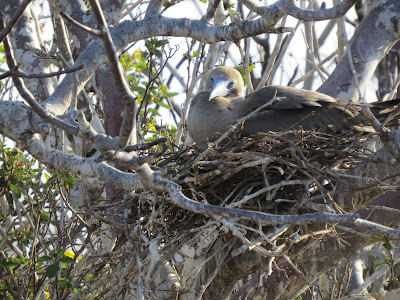 |
| The heads of these marine iguanas basking in the sun look just like the surrounding rocks. |
Survival of the fittest. Adaptation of the species.
Familiar phrases, but what do they mean? In the simplest terms, they mean that animals have, over time, changed in ways that give them the ability to survive despite challenges in their environment. One such adaptation is the ability to change color to blend into the surrounding landscape, thus offering protection from predators. The volcanic land masses on the Galapagos Islands are predominantly shades of earthy tones in browns, tans, blacks, siennas, whites, grays and dusty greens. With few exceptions, this means the birds and wild life blend into their surroundings, protecting them from hawks and other prey.
In this post, I share with you some of my photos that graphically show how millions of years of adaptation protect our precious life forms.
 |
| You might walk by this bird's nest dozens of times before realizing its presence. |
 |
| A little boobie chick hiding in the bushes. |
 |
| These boobies are disguised by the rock surface and their own guano. |
 |
Look hard to discern the boobies and iguanas hiding out on this rocky embankment.
|
 |
| Don't see anything at all? Look between the rocks at the Galapagos dove. |
 |
| There's a tiny warbler on the rock in the middle of this photo. |
 |
| The flightless cormorant takes on all the earthy tones of his surroundings. |
 |
| What do you see? Sea lions, cormorants, iguanas and Sally Lightfoot Crabs populate this photo. |
 |
| The whole family is in hiding! |
 |
| This photo was a miracle. I shot in the general direction of the finch because I couldn't see him at all in the ground cover. What a surprise that I caught him with his mouth full. |
 |
| Don't you just love how this guy burrowed between the rocks? Though one might step on his head if not careful. |
 |
| No one wants to be disturbed in this activity, so they blend right in. I knew what to look for though. |
 |
| This is a favorite of mine. Where does the bird stop and the sand begin? |
.JPG) |
| There are iguanas literally all over this terrain. |
 |
| Can you discern this one at all? Brown noddies are nearly indistinguishable from their perches. |
 |
| When I found this little guy hiding in a crevasse, we were at least 100 feet away. No one could see him but me, so I took this photo to prove he was there. |
 |
| This is just a great photo showing a wide range of browns and textures. |
 |
| A brown pelican in the pelican nesting area doesn't want to be disturbed. |
 |
| Penguinos! It sometimes takes an experienced eye to find these delightful animals. These posed for the camera. |
 |
| Look at this tortoise's pattern against the dry path. It could be just another rock. |
.JPG) |
| Many birds look like the rocky coast where they mate and, as babies, learn to fly. The coloration especially helps keep the babies safe from watchful hawks. |
 |
| He needs his red feet for mating, otherwise he's blended into his environment. |
 |
| There are three iguanas in these trees. When this picture was taken, I thought there were only two. Only later did my eye catch the third. Can you find it? |
.JPG) |
| More iguanas find their resting places in tight camouflages spots. |
 |
| The lava lizards are different on every island. But, on each they blend into that island's landscape. |
.JPG) |
| Don't step on the snail! |
 |
| Or the snake! |
 |
| Rocks or tortoises? Hard to tell. |
I hope you enjoyed these tricks of nature. I certainly love sharing them with you.














.JPG)






.JPG)
.jpg)


.JPG)

.JPG)









.JPG)


.jpg)

.JPG)
.JPG)

This comment has been removed by the author.
ReplyDeleteThankfulness to my dad who informed me relating to this blog, this website is really amazing.
ReplyDeletekbmdc.org/iguanas-cage-supplies-reptile/
Additionally, if you do most of the viewing from a sitting or standing position as on a boat, hunting binoculars
ReplyDelete